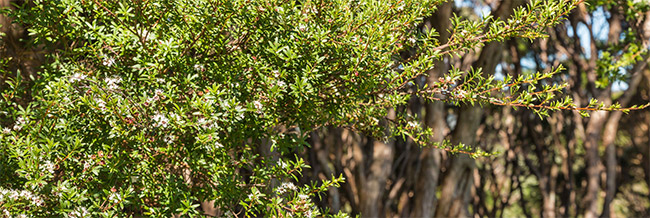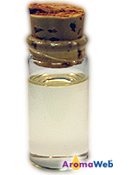Manuka Essential Oil
Leptospermum scoparium

Description
Manuka Essential Oil is also known as New Zealand Tea Tree Essential Oil.
I first fell in love with Manuka Essential Oil back in the 1990s. Although it's also known as New Zealand Tea Tree Essential Oil and shares many of the same therapeutic benefits as Australian Tea Tree Essential Oil (Melaleuca alternifolia), the aroma of Manuka Essential Oil does not have the medicinal aroma that Tea Tree does.
Aromatically, Manuka Essential Oil is earthy, yet fresh and pleasant.
I tend to use Australian Tea Tree for those times that I need it strictly for physical or skin care applications. Because Manuka Essential Oil is a bit more costly, I tend to choose it for those times in which its aroma and emotional benefits will come into play.
Emotionally, Manuka Essential Oil tends to be a balancing and soothing essential oil that is grounding when needed. Although it cannot be closely compared to the smell of the earth after a fresh summer rain, smelling Manuka Essential Oil brings me a similar sense of joy and peace when I inhale it. Within his Manuka Essential Oil Profile, Salvatore Battaglia shares that "Von Braunschweig says that manuka is a protective oil similar to myrrh and cedarwood. She says that old psychic scars get smoothed and that the sesquiterpenes stabilise and protect the nervous system and balance the sympathetic and parasympathetic nerves. Manuka's vitalizing scent is well suited to gentle souls who express themselves through sensitive skin or frequent digestive upsets." [R. Von Braunschweig. Manuka, Kanuka and Tea Tree Oil - 3 Eessential Oils with Interesting Effects on the Psyche. Proceedings of the Australiasian Aromatherapy Conference, Sydney, 1998. Source cited in Salvatore Battaglia, The Complete Guide to Aromatherapy (Australia: The Perfect Potion, 2003), 228.]

Manuka Essential Oil blends well with essential oils in the wood, citrus, herbaceous, spice, mint and medicinal families. Although I characterize it as a middle note, I do find that it possesses characteristics of a base note, and it makes a good bridge between middle and base notes within natural fragrancing and blending applications.
Like many essential oils, Manuka Essential Oil can vary in its composition based on where the tree is grown. However, I've noticed that most Manuka Essential Oils that I've seen to date are particularly abundant in sesquiterpenes (50-70%) followed by approximately 20% ketones with single percentages of sesquiterpenols and monoterpenes. In comparison, Australian Tea Tree Essential Oil (Melaleuca alternifolia), is most abundant in monoterpenes and monoterpenols with a small amount of oxides (particularly 1,8 cineole).
The composition of Manuka Essential Oil lends it to possess a much longer shelf life than Australian Tea Tree essential oil.
Manuka Essential Oil Benefits and Uses
- Bronchial Infections
- Bronchitis
- Catarrh
- Coughs
- Influenza
- Skin Infections
- Wounds
- Cuts
- Contusions
- Fungal Skin Infections
- Athlete'S Foot
- Parasitic Infection
- Ringworm
- Mites
- Head Lice
- Scabies
Source: Valerie Ann Worwood, The Complete Book of Essential Oils and Aromatherapy, 25th Anniversary Edition (Novato, CA: New World Library, 2016, 553.
Botanical Name
Plant Family
Common Method of Extraction
Steam Distilled
Plant Part Typically Used
Color
Clear to Pale Yellow
Consistency
Medium
Perfumery Note
Middle
Strength of Initial Aroma
Medium
Aromatic Description
Manuka Essential Oil smells woody, earthy and balsamic.
Sustainability and Conservation Status
Least Concern
Source: https://www.iucnredlist.org/species/161478142/161483629
To learn more about the conservation status of essential oil bearing plants and how to use the IUCN Red List of Threatened Species, please refer to AromaWeb's Guide to Essential Oils and Sustainability.
Major Constituents
- Leptospermone
- (E)-Calamenene
- a-Pinene
- Cadina-3,5-diene
- Delta-Cadinene
- a-Copaene
- Favesone
- Cadina-1,4-diene
- B-Selinene
- a-Selinene
- Isoleptospermone
See Essential Oil Safety for more complete list of typical constituents.
Source: B.M. Lawrence, Progress in Essential Oils. (Perfumer & Flavorist 26 no. 2, 2001), 22-25. Source cited in Robert Tisserand and Rodney Young, Essential Oil Safety (Second Edition. United Kingdom: Churchill Livingstone Elsevier, 2014), 344.
Manuka Essential Oil Safety Information
Tisserand and Young do not indicate any special precautions when using Manuka Essential Oil. Reading Tisserand and Young's full profile is recommended. [Robert Tisserand and Rodney Young, Essential Oil Safety (Second Edition. United Kingdom: Churchill Livingstone Elsevier, 2014), 344-345.]
General Safety Information
Do not take any oils internally and do not apply undiluted essential oils, absolutes, CO2s or other concentrated essences onto the skin without advanced essential oil knowledge or consultation from a qualified aromatherapy practitioner. For general dilution information, read AromaWeb's Guide to Diluting Essential Oils. If you are pregnant, epileptic, have liver damage, have cancer, or have any other medical problem, use oils only under the proper guidance of a qualified aromatherapy practitioner. Use extreme caution when using oils with children and be sure to first read the recommended dilution ratios for children. Consult a qualified aromatherapy practitioner before using oils with children, the elderly, if you have medical issues or are taking medications. Before using this or any essential oil, carefully read AromaWeb's Essential Oil Safety Information page. For in-depth information on oil safety issues, read Essential Oil Safety by Robert Tisserand and Rodney Young.
Shelf Life
Important Information About the Profiles
The essential oil information provided on AromaWeb is intended for basic educational purposes only. The references to safety information, test results, constituents and percentages is generalized information. Essential oils can vary greatly in composition. The data is not necessary complete and is not guaranteed to be accurate. The essential oil photos are intended to represent the typical and approximate color of each essential oil. However, essential oil composition and color can vary based on harvesting, distillation, age of the essential oil and other factors. Profiles for several CO2 Extracts and absolutes are included within the directory, and are denoted as such.
